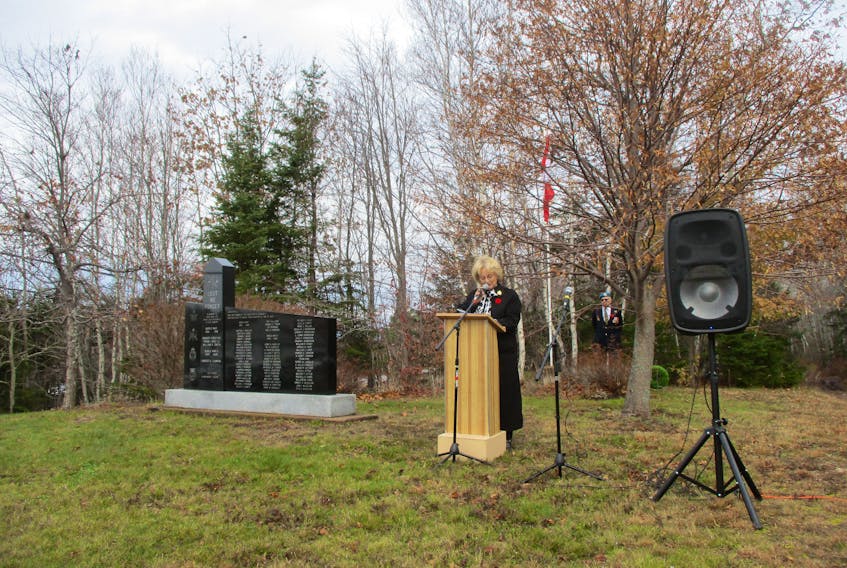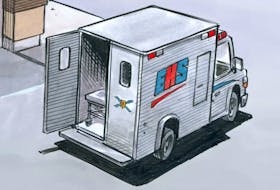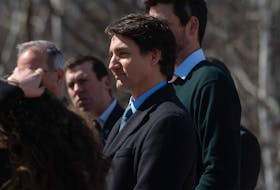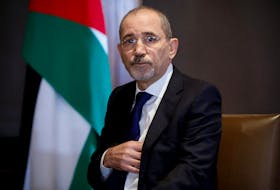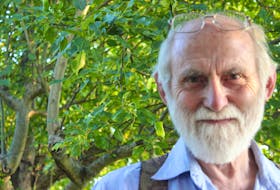The Wentworth Cenotaph stands on the top of a long sloping hill and can be easily seen when driving or walking by on Highway 4 so that the memory remains that many served and are now serving in the armed forces to keep Wentworth safe, democratic, and free from dictatorships.
However, on Remembrance Day the Cenotaph becomes alive with a special Ceremony following the precept Lest We Forget. A large crowd came including the Wentworth Volunteer Fire Department dressed in attractive uniforms.
One of the miracles of Remembrance Day are the thousands of poppies as a result of the poem beginning “In Flanders Field the poppies blow / Between the crosses row on row” written by Canadian Lieutenant Colonel John McCrae, soldier, doctor, and poet at a very important battle of WW1 at Passchendaele in Belgium, where McCrae was involved in the Second Battle of Ypres.
The poem was written by McCrae on May 3, 1915 after presiding over a funeral of a fellow soldier and friend who had died in at the Second Battle of Ypres.
Three years later, McCrae died of cerebral meningitis in a military hospital. His legacy of poppies is celebrated every year in Canada.
Jocelyn Morris co-ordinated and planned the Wentworth Remembrance Day Ceremony and had the aid of Carmen Baker (playing trumpet) and Sharon Miller (singing).
In her opening remarks Jocelyn Morris researched statistics to reveal heart-breaking facts about the sacrifices made to make Canada free and safe. It was startling and sad to learn how many Canadians had lost their lives especially in First and Second World Wars.
In the First World War, 1914-1918, 650,000 Canadians served, 66,000 died, and 172,000 were wounded; in the Second World War, 1939-1945, 1,159,000 Canadian served, 44,090 died, and 55,000 were wounded. This sample of those serving tears at the heart strings and says we need to remember.
Jocelyn Morris said a prayer and asked us all to sing “O Canada.” Then her program begins with people from the audience speaking words of great literature or performing great music
Act of Remembrance: Rick Clarke spoke:“They shall not grow old as we that are left grow old /Age shall not weary them, nor the years condemn/ At the going down of the sun and in the morning/ we will remember them.”
All of us responded: “We will remember them.”
Last Post: Carmen Baker plays the trumpet. This symbolizes death. Followed by two minutes of silence.
Reveille: Carmen plays the trumpet signifies the resurrection of the spirit of the fallen.
Commitment to Remember: Max Baker states: “They were young as we are young/ They served, given freely of themselves/ To them, we pledge, amid the winds of time/ To carry their torch and never forget/ We will remember them.”
Jocelyn Morris began having people laying of wreathes and crosses at the Cenotaph. She states the names of those to be honoured and the names of those who are presenting and the names of those who are placing the wreaths & crosses. Those placing the wreaths and crosses then stand for a moment before the Cenotaph out of respect.
Jocelyn Morris thanked the audience for coming, those who fought and died, veterans, and those currently serving. Sharon Miller then sang “God Bless You Canada.”
Jocelyn Morris asked that all present remove their poppies and place them with the wreaths and crosses at the cenotaph and then she invited all those present to go across the road to the recreation centre where we had been invited.
At the recreation centre a tasty lunch and friendship were enjoyed. I was especially attracted to a display designed and printed by teenager Morgan Patriquin, age 15, who said of his project that he is interested in keeping stories alive for future generations, He wrote about his great, great uncles, James Hayman and Frasier Hayman, and their service in the Second World War. James Hayman suffered a head injury and lost hearing in one ear and was involved in invasions of Sicily, Italy, and North Western Europe. Frasier Hayman fought in Operation Overlord at Juno Beach, France and Belgium. He was wounded twice in battle. His mother was informed he was killed and later this turned out to be false and he returned home!
I found Morgan Patriquin’s display to be excellent.
Hope Bridgewater writes for the Wentworth area for the Amherst News

